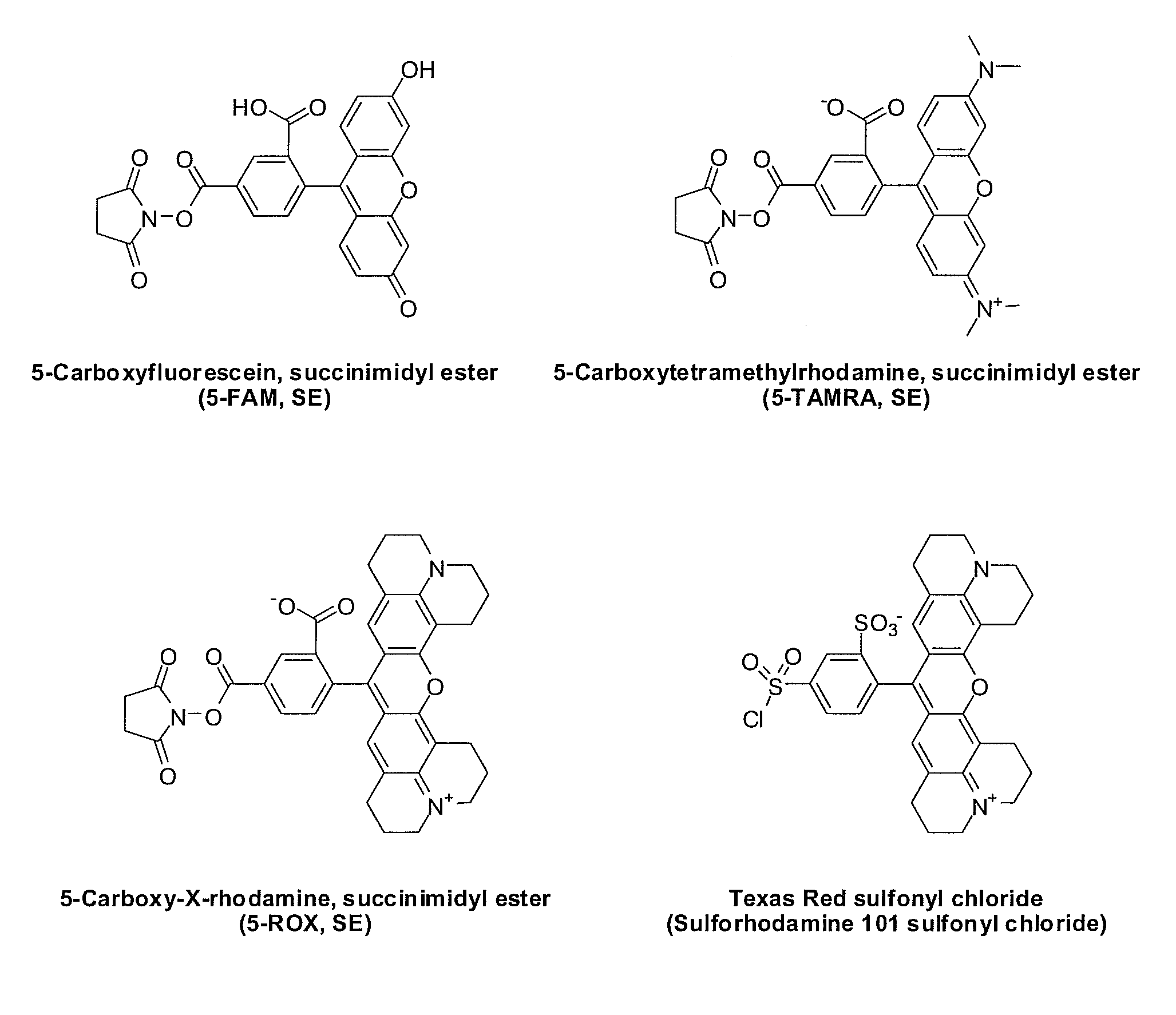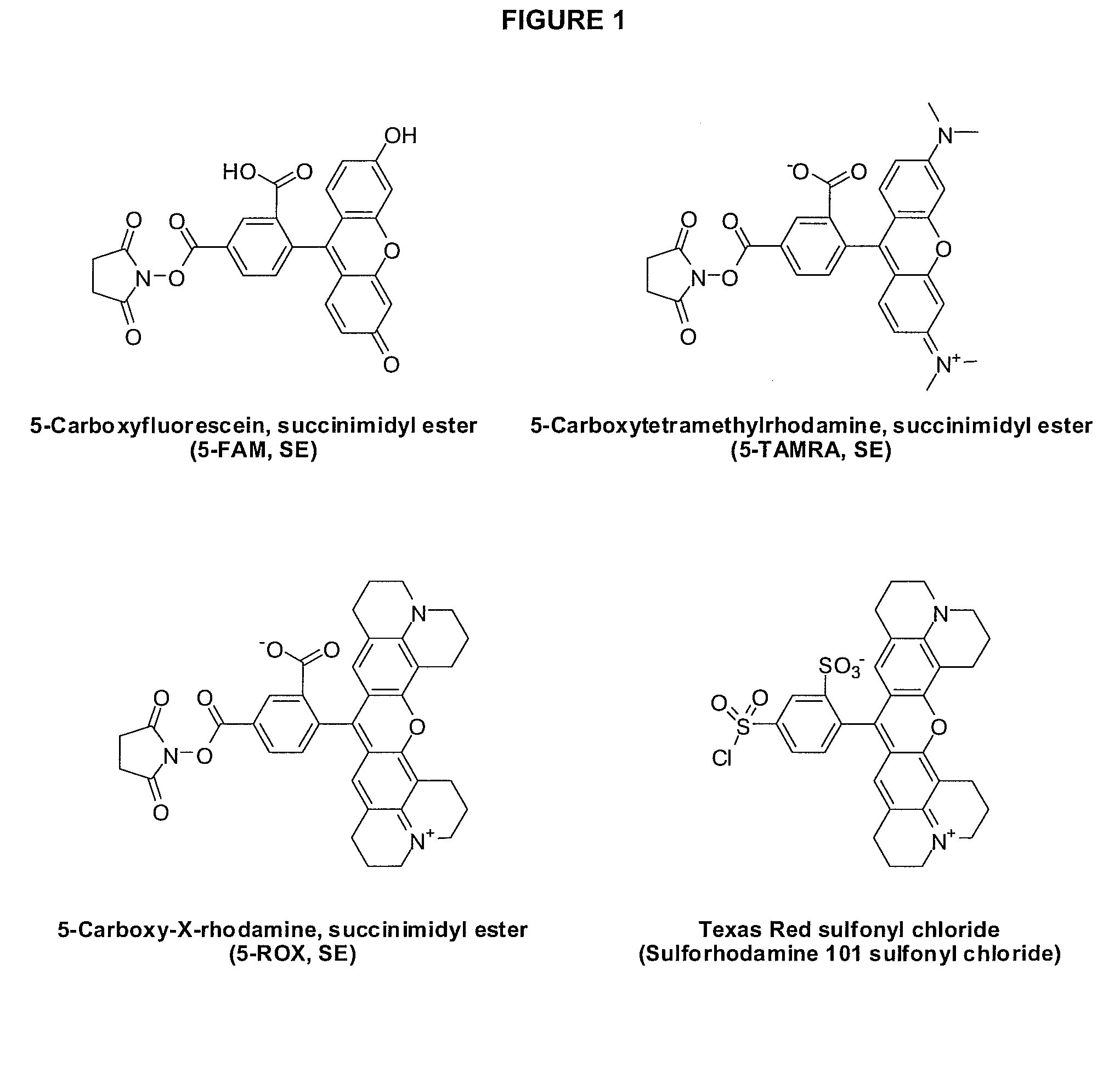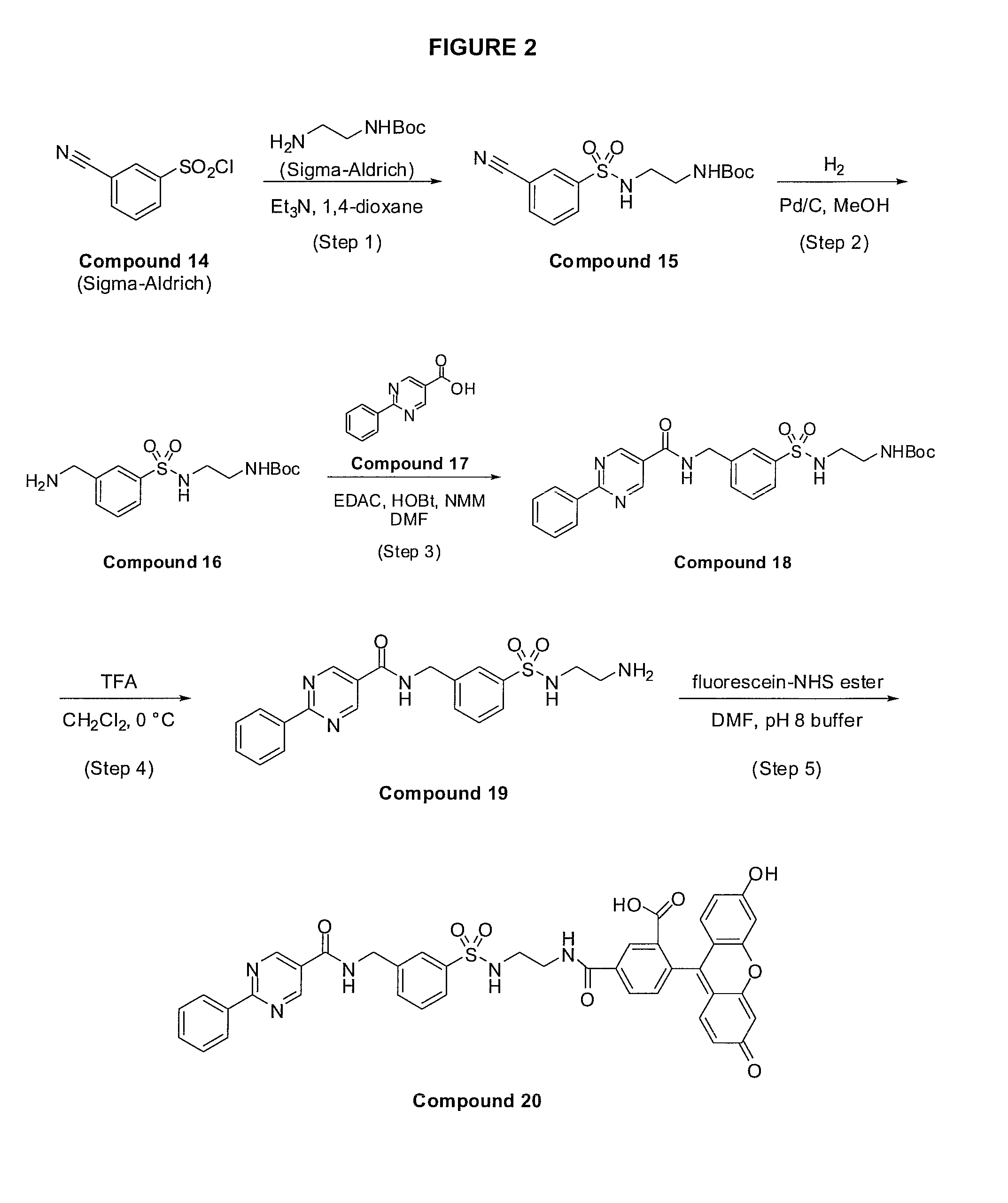Method for assaying compounds or agents for ability to displace potent ligands of hematopoietic prostaglandin D synthase
a technology of hematopoietic prostaglandin and affinity assay, which is applied in chemical methods analysis, instruments, enzymology, etc., can solve the problems of general bias of gst assay, inability to high-throughput screening (hts), and inability to screen compounds or agents for affinity to hematopoietic prostaglandin d synthase, so as to increase enzyme mass and slow down molecular rotation
- Summary
- Abstract
- Description
- Claims
- Application Information
AI Technical Summary
Benefits of technology
Problems solved by technology
Method used
Image
Examples
example 1
Fluorescence Polarization Assay
[0104]Detection analyte and H-PGDS-MBP fusion enzyme were incubated in the presence of reduced glutathione (5 mM) for 30-60 minutes at room temperature and FP was measured using a TECAN SAFIRE 2 plate reader equipped with absorbance, fluorescence, fluorescence polarization and FRET capabilities. Assays were performed in 96-well microtiter plates in 100 μL of total sample volume. Excitation and emission wavelengths appropriate for the employed detection analyte were used.
[0105]Step 1: Preparation of Reagents
[0106](a). Detection Analyte: H-PGDS FP Fluorescent Probe—Green
[0107]FP buffer concentrate (4×(200 mM Tris pH8.0, 200 mM KCl, 20 mM CHAPS, 40 mM DTT), Cayman Chemical Catalog No. 600028, 6 mL) was diluted with deionized water (18 mL) to provide 1×FP buffer (24 mL).
[0108]A solution consisting of 2-(6-hydroxy-3-oxo-3H-xanthen-9-yl)-5-(2-(3-((2-phenylpyrimidine-5-carboxamido)methyl)phenylsulfonamido)ethylcarbamoyl)benzoic acid (Compound 20, see Example ...
example 2
Preparation of 2-phenyl-N-(2-(phenylamino)ethyl)pyrimidine-5-carboxamide (Compound 10)
[0142]To a stirring mixture consisting of 2-phenylpyrimidine-5-carboxylic acid (Compound 17; synthesis described in Example 1, Steps 1-3 of WO 2007 / 041634 to Aldous et al., entitled “Pyrimidine Amide Compounds as PGDS Inhibitors”; 200 mg) in N,N-dimethylformamide (15 mL) was added successively N-methylmorpholine (Aldrich, 0.33 mL), N-phenethylenediamine (Acros, 173 mg), 1-hydroxybenzotriazole (209 mg), and 1-(3-dimethylamino-propyl)-3-ethylcarbodiimide hydrochloride (EDAC, 227 mg). The reaction mixture was stirred overnight under an argon atmosphere and was subsequently concentrated slightly under reduced pressure. The concentrate was partitioned between ethyl acetate (200 mL) and saturated aqueous sodium bicarbonate (200 mL). The layers were separated and the organic phase was washed twice with water (2×200 mL) and once with brine solution (200 mL), was dried over anhydrous magnesium sulfate, filt...
example 3
Preparation of N-benzyl-2-(3-fluorophenyl)-4-methylthiazole-5-carboxamide (Compound 11)
[0143]Step 1: Preparation of N-benzyl-2-bromo-4-methylthiazole-5-carboxamide
[0144]
[0145]To a mixture consisting of 2-bromo-4-methylthiazole-5-carboxylic acid (Sigma-Aldrich, 1.0 g), 1-(3-dimethylamino-propyl)-3-ethylcarbodiimide (EDC, 1.3 g), 1-hydroxybenzotriazole (0.613 g), N-methyl-2-pyrrolidinone (0.48 mL) in N,N-dimethylformamide was added a mixture consisting of benzylamine (0.54 mL) in N,N-dimethylformamide (5 mL). The reaction mixture was stirred overnight at room temperature and was subsequently partitioned between ethyl acetate (200 mL) and water (200 mL). The layers were separated and the organic phase was further washed twice with water (2×200 mL) and brine solution (150 mL), was dried over anhydrous sodium sulfate, filtered, and concentrated under reduced pressure afforded the title intermediate as a crude yellow oil (1.847 g; major spot Rf 0.45 with 3:1 v / v hexanes-ethyl acetate solv...
PUM
| Property | Measurement | Unit |
|---|---|---|
| excitation wavelengths | aaaaa | aaaaa |
| emission wavelengths | aaaaa | aaaaa |
| emission wavelengths | aaaaa | aaaaa |
Abstract
Description
Claims
Application Information
 Login to View More
Login to View More - R&D
- Intellectual Property
- Life Sciences
- Materials
- Tech Scout
- Unparalleled Data Quality
- Higher Quality Content
- 60% Fewer Hallucinations
Browse by: Latest US Patents, China's latest patents, Technical Efficacy Thesaurus, Application Domain, Technology Topic, Popular Technical Reports.
© 2025 PatSnap. All rights reserved.Legal|Privacy policy|Modern Slavery Act Transparency Statement|Sitemap|About US| Contact US: help@patsnap.com



